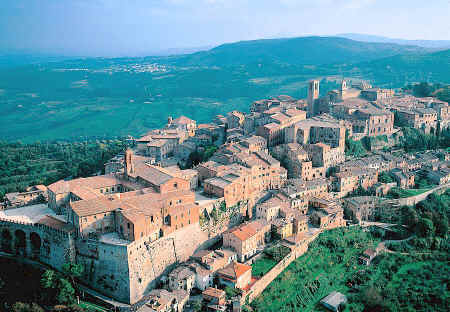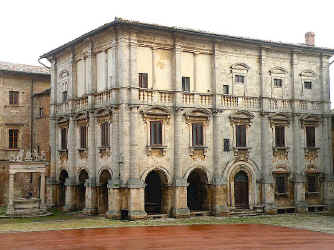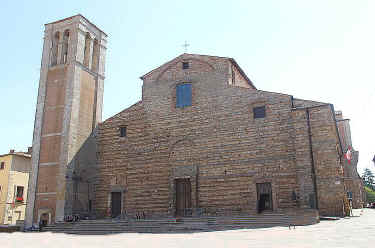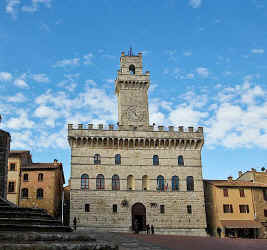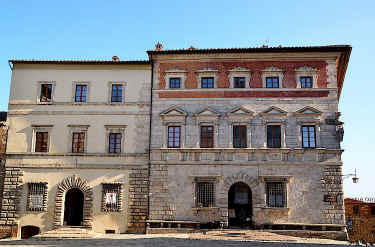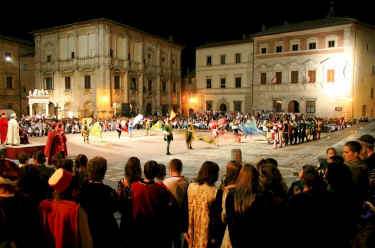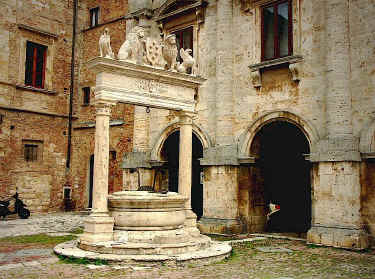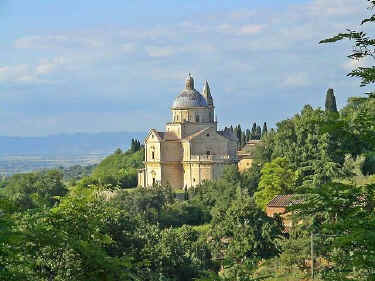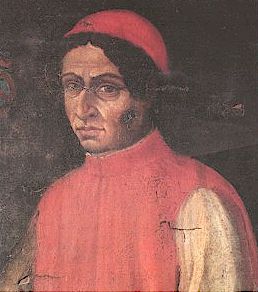|
Montepulciano is built along a narrow limestone ridge at 605 m above sea level. A long, winding street called the Corso climbs up to the main square, which crowns the summit of the hill. The town is encircled by walls and fortifications designed by Antonio da Sangallo the Elder in 1511 for Cosimo I. Inside the walls, the streets are crammed with Renaissance-style palazzi and churches, but the town is chiefly known for its "Vino Nobile" wines. Arriving at Montepulciano after having passed round the top of the hill along the beautiful tree-lined street and past Poggiofanti Gardens, you come to the Church of St. Agnes, the patron saint of Montepulciano, who died in 1317. In its modern facade (1926) there is a Gothic portal. The interior of the church was renovated in the 18 C, the nave mostly in the XVII century. Many art works in the church date back to this period, among them the monument where St. Agnes's body rests. Montepulciano - Via RomaFollowing the avenue, you reach Porta al Prato where the Via Roma starts. Following Via Roma, you reach a little square where the "Marzocco", the symbol of Florence's authority, stands on a column. This lion replaced the "She-wolf", the symbol of Siena, in 1511 and is the work of the sculptor, Sarrocchi (1856). In front of the column is the Palazzo Avignonesi which is attributed to Vignola and dates back to the 16 C. Its style is pure late-Renaissance. Close to the Palazzo Avignonesi stands the Baroque Church of St. Bernard and in front of the Palazzo Avignonesi there is the late-Renaissance Palazzo Tarugi. Its lower level is characterized by ashlar-work. This building is also attributed to Vignola. Other Renaissance palaces bordering the Via Roma are: Palazzo Cocconi-Del Pecora, designed by Antonio da Sangallo, and Palazzo Buccelli with Etruscan cinerary urns and tablets with Etruscan and Latin inscriptions displayed at its base.
Church of St. Augustine
Be sure to visit the Church of St. Augustine, one of the most beautiful and interesting buildings in Montepulciano. Its facade was designed by
Michelozzo Michelozzi (1396-1472) in the first
decade of the 15 C. As Brunelleschi's disciple and collaborator, as
an architect, and Donatello's disciple as a sculptor, the artist used simple and elegant Renaissance forms in the lower level. The portal
has a lunette placed in the upper level and on its top an irregular tympanum stands between two thin and pointed towers like
flames. They represent Gothic features which recur in the Gothic niches of the upper level.
It is possible that the remaining part of the facade was completed by another architect who
adopted Renaissance forms. The inside was rebuilt in the 18 C and the original design was transformed. Inside, you can admire works by Barocci, Allori, Lorenzo di Credi. On the high altar there is a wooden
crucifix attributed to Donatello. Continue downwards
Going downwards, on the left, you reach Palazzo Cappelli with frescoes by F. Zuccari at the entrance. Piazza Grande of MontepulcianoOn the right of the church, take the street which goes around the Fortress and comes out in Piazza Grande. This is the ideal and monumental centre of Montepulciano. It is one of the most beautiful squares of the minor towns of Tuscany, and preserves in silence recollections of past magnificence and high civilization. The square is bordered by important buildings: the Cathedral, with its unfinished facade; on the left, the unfinished Bell Tower dating back to the second half of the 15 C. Montepulciano - il DuomoWhere the Cathedral stands today, there was an ancient parish church which came to be considered to be inadequate and bare when beautiful buildings were built in Piazza Grande and the nearby streets. In 1583 the ancient sacristy began being pulled down and, after much debate, Bartolomeo Ammannati was asked to provide a new design which was ready in 1588. However, some years passed before work began. Meanwhile, Ammannati died. In 1593 Ippolito Scalza, a sculptor and architect of Orvieto, was employed. He adjusted the design and most probably completely rearranged the plan. In 1594, construction began and in 1680 the church was consecrated. However, the facade was never finished. Duomo of Montepulciano The inside consists of three aisles divided by arches resting on pillars. On the sides there are chapels. On the high altar you can admire the monumental polyptych by Taddeo di Bartolo (1410), a painter of Siena who was born in 1362 and died in 1422. In Padua he was in touch with Altichiero, one of Giotto's disciples, and he was influenced also by other painters from the Northern Italy such as Giovanni of Milan and Barnaba of Modena. It is one of his richest and most famous works, and very beautiful. It represents at its centre Our Lady's Assumption among Saints piously gathered around Her; on the top and at the centre the Coronation; laterally the Annunciation and on the pillars many figures of Saints. At the sides of the high altar stand two statues that form part of the Aragazzi Monument, representing Fortitude and Justice or Science and Faith. On the right of the high altar, leaning on a pillar, there is a fine representation of St. Bartholomew blessing the congregation. According to the ideal reconstruction of the Aragazzi Monument, the Saint ought to have been on the tomb to turn to the dead. A design of the facade of the Cathedral and the reconstruction of the Aragazzi Monument, designed by Emanuele Marcucci, are kept in the Sacristy.
Montepulciano Palazzo ComunaleThe Town Hall with its beautiful central tower dates back to the 16 C and brings to mind the Palazzo Vecchio in Florence. It is a simple building with Guelph merlons and solid corbels. In the lower part, the ashlar-work is irregular and rough, in contrast to the openings of the rectangular windows which are present in the upper level in a regular rhythm. From the tower you can admire a beautiful panorama during clear and bright days. In front of the Town Hall is Palazzo Del Monte (today Palazzo Contucci). In 1519 Antonio da Sangallo the Elder began work ordered by the Cardinal of Santa Prossede, Antonio Ciocchi Del Monte, who was Pope under the name of Julius III. The Cardinal caused many buildings to be pulled down to make room for the palace defined by Vasari as "well refined and constructed with great elegance". Flag throwing in the Piazza Comunale of Montepulciano
In front of the Cathedral you can admire the austere Palazzo Nobili (today
Palazzo Tarugi) attributed to Antonio da Sangallo the
Elder. The porch, which today is blind, followed the rhythm of columns in the lower level. Windows rest on small corbels and support a curved gable; the noble portal is decorated by round arches. The well located in the Piazza Comunale of Montepulciano
When you reach to Via Ricci, you will find on the left a building attributed to Baldassarre Peruzzi
(16 C), the Palazzo Ricci. Its facade underlines the elegant rhythm of the surface by a cornice gathering windows and
recurring on the upper level at the base of the mezzanine. The Church of the Madonna di San BiagioAfter having visited the town, go next to the church of the Madonna di San Biagio designed by Antonio di Francesco Giamberti, known as Antonio da Sangallo the Elder, and consecrated by Pope Clement VII in 1529. It rises in open country below the city walls and was built on the remains of the ancient parish church of St. Blaise where, according to tradition, a painting of Our Lady was seen moving her eyes. Tempio di San Biagio outside Montepulciano It presents a Greek-cross plan surmounted by a dome and with four equal wings. In the south wing there is a semicircular sacristy. On both sides of the northern wing, there are bell towers, one of which is unfinished. All the wings display a Doric lower level with metopes and triglyphs as a seal. The upper level has an architrave and is surmounted by a tympanum. Simple decorations adorn classical portals and windows. The dome stands on a tambour divided by Ionic pilaster strips alternating with niches. It ends with a narrow and elegant lantern. Inside, there few decorations other than the rhythm of large arches and classical ornamental elements, such as tympanums, metopes, triglyphs and niches with their altars in harmony ending with the narrow dome illuminated by the lantern. The big high altar is by Albertini (1584). Frescoes representing the Transition, the Assumption and the Coronation of Our Lady are attributed to Zuccari (16 C). In front of the church there is the Plebiscite or the Rectory of St. Blaise. The beautiful well with its curved line is similar to the well in Piazza Grande. The legend of the foundation of MontepulcianoIn keeping with its past civilization, Montepulciano has a founding legend. In fact, the town is said to originate with a noble who withdrew from Chiusi during the first barbaric invasions. He dwelt on this splendid hill which took the name "Mons Politus e Polictus" - the Mount of the Noble. The common people of Chiusi went to Città dell Pieve which, as a result, took the name "Civitas Plebis". The more important version of the founding legend is that Larte Porsena, the lucumon of Chiusi (Charmas) founded the village or that it was built after an hypothetical destruction of Chiusi in the times of Papiro Carbone and Silla. History of MontepulcianoOn the Hill of Poliziano, there was a temple dedicated to Mercury from
which it took the name Mons Mercurius. The presence of many Etruscan remains
indicates that Montepulciano's outskirts have been inhabited since that period. However, according to some scholars, the fact that the temple which was set up
on the location of the present Fortress and which was dedicated to St. Donatus in 361
implies that this place was not inhabited during the Roman period. It
was possibly not inhabited until the 6 C when the population of Chiusi
arrived, having been put to flight by barbarian invasions. They first
settled in the area known as Collazzi. Evidence for the existence of this town appeared for the first time in a document of 715 where it is clearly named as "Mons Politianus". Montepulciano was given the title of "imperial town" by Otto I. It was always
the subject of contention among Florence,
Siena, Perugia
and Orvieto, even when the town enjoy independence and autonomy.
|
